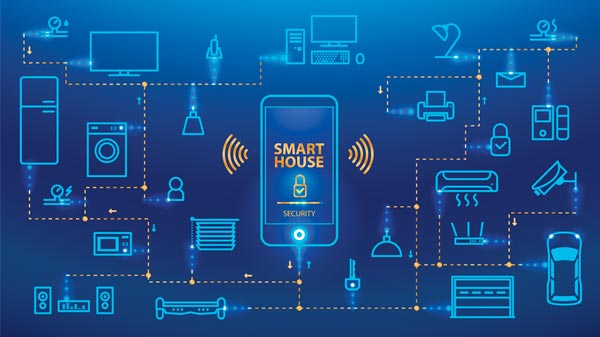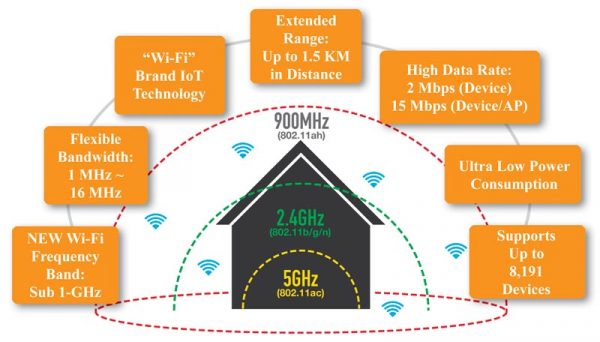
With 10dB more than conventional Wi-Fi, a HaLow wireless signal penetrates walls and is therefore ideal for smart home applications. (© Shutterstock)
High data rates and a simple network structure have made Wi-Fi one of the most common wireless standards. But Wi-Fi has a flaw – its low range. This is why the Wi-Fi Alliance developed IEEE 802.11ah for longer-distance wireless. The first module to meet this standard is now appearing on the market.
Unlike the usual standards, which operate at 2.4GHz or 5GHz bands, the IEEE 802.11ah standard – also known as Wi-Fi HaLow –uses the unlicensed 900MHz frequency band for transmission. This makes it part of the LPWAN group of technologies (Low-Power Wide-Area Networking) along with LoRa and Sigfox. The use of the lower frequency band means that HaLow achieves a range of up to 1.5 kilometers, almost twice the distance of Wi-Fi standards based on 2.4GHz or 5GHz. This is a compelling prospect for not only smart home applications but also various IoT scenarios such as industrial enterprises with large premises, in agriculture, in healthcare, and in smart cities.
Passes Through Walls More Easily
Wi-Fi HaLow also establishes a very stable connection – because there is at least 10dB more available in the link budget compared to 2.4GHz WiFi, a wireless signal can pass through walls or other obstacles more effectively. A theoretical maximum of up to 8,191 devices per access point are supported; the first 802.11ah Wi-Fi module for IoT devices from Silex (see more below) supports 1,024 nodes per access point. In a practical test, Silex successfully had data transmitted over 100 connections and 30 fixed devices essentially simultaneously.

The new 802.11ah Wi-Fi standard offers a much greater range than the other Wi-Fi standards. (© Silex)
This new version of Wi-Fi is also attractive for mobile applications such as wearables and sensor applications – a data rate of at least 150 Kbit/s is available when using a 1MHz channel. If the sensors are only active when new data needs to be transmitted, this can be achieved with low power usage in combination with a low-power data modem, making Wi-Fi HaLow ideal for connecting many smaller devices. By combining multiple channels, it becomes possible to increase the data rate a little. Interoperability between 802.11ah devices from different suppliers is ensured, with the WLAN encryption standards WPA2-PSK, WPA3SAE and WPA3-OWE guaranteeing secure data transmission.
IEEE 802.11ah or Wi-Fi HaLow therefore combines the benefits of Wi-Fi and of LPWAN technologies, offering not only greater range but also a higher data rate. However, the technology is still in its infancy, the infrastructure is still under development, and there are gradually more and more devices, that support the standard appearing for sale.
First HaLow Components
One of the pioneers was Japanese manufacturer Newracom, which developed the first Wi-Fi HaLow chip back in October 2015 for IoT applications. This chip was presented along the standard at the Mobile World Congress 2016. Newracom won the “Best Wi-Fi IoT Product 2019” award in 2019 for the NRC7292, the first IEEE 802.11ah-compatible Wi-Fi HaLow SoC.
Another pioneer of this new standard is Silex. The SX-NEWAH, the first 802.11ah Wi-Fi module for IoT devices, will soon be available through Rutronik. The US version is already available with Rutronik offering samples. This module is also based on the NRC7292 SoC from Newracom and is the first industrial Wi-Fi module to operate in the sub-GHz band. This means that it offers all of the benefits of the new Wi-Fi technology:
- Greater range and stable connections, including through walls or in adverse environment conditions, with at least 10dB more than with 2.4GHz Wi-Fi
- Low power usage for a battery life of several years
- Data rates of up to 15 Mbit/s with TCP/IP support
- A large number of devices per access point (repeaters and gateways are not needed)
- IP connectivity: The module can be integrated into existing IP networks.
- High security: Enterprise Wi-Fi Security, WPA3
- Interoperability with 802.11ah devices from different suppliers
Author: Kerstin Naser, Product Sales Manager Wireless at Rutronik
Rutronik | https://www.rutronik.com
![]()



